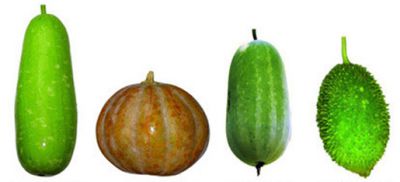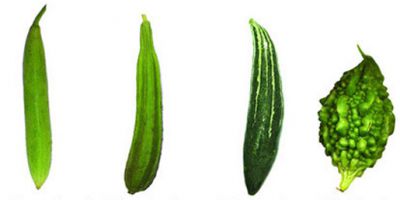Gourd
Gourd (lau-kumda) hard-shelled fruits of the family Cucurbitaceae. Plants of these species are trailing annual herbs. In Bangladesh the most popular gourds are yellow-flowered pumpkins (Cucurbita maxima) and white flowered bottle gourds (Lageneria vulgaris). These two gourds have a long association with man, and were never found in a truly wild state. The term gourd has been broadened to include ash gourd, teasle gourd, ribbed gourd, snake gourd, and sponge gourd. In rural Bangladesh gourd is largely grown in homestead gardens on bamboo-framed platforms or on thatched roofs.

Bottle Gourd (lau) generally a winter crop, Lageneria vulgaris, possibly tropical or sub-tropical in origin, rich in carotene, calcium and vitamin C. In Bangladesh it is cultivated in about 10,000 ha, producing about 62,000 m tons; grown by direct sowing or transplanting 15 to 20 days old seedlings; crops are ready for harvest within 55-60 days; yield ranges from 35-40 m tons/ha. Some varieties of bottle gourd are BARI Lau-1, Khetlau and Hazari. Bottle gourd is primarily used in making curry with different fishes.
Its leaves and vines are also used as vegetables. The tender bottle gourd is used to prepare sweet dishes with sugar and milk.
Pumpkin (mistikumda) popular summer-rainy season vegetable, Cucubrita maxima, good source of carbohydrate, vitamin A and C, and minerals. It is grown in Bangladesh in an area of about 14,000 ha. Pumpkin is thought to be native to Northern and Southern America. It may be grown by sowing seeds directly or transplanting two weeks old seedlings. Fully ripened pumpkins are harvested within 90 days after sowing. Two local varieties are Bikrampuri and Baromashi. The average yield is 20-25 m tons/ha. Leaves, vines, flower and fruits are edible as vegetable. Fruits are used in making curry and different sweet dishes. Ripe whole fruits can be preserved dry for several months.
Ash Gourd (chalkumda) popularly known as chalkumda, Benincasa hispida, is possibly a native of the subcontinent. It can be grown in any type of soil but loamy to sandy loamy soil is preferred. The optimum time for sowing seeds is February to March; green fruits are ready for harvest within 45-60 days; matured ones coated with powdery substance are harvested between 80 and 90 days after sowing. Plants are grown from local varieties namely Sachi kumra and Dimi kumra; yield ranges from 20-30 m tons/ha. Tender leaves and twigs are consumed as leafy vegetables. Green fruits are used in making curry with fish or other vegetables; sometimes fried for consumption. Matured fruits are smashed and mixed with black gram to make 'Bori', which look like 'wax apple' and then dried in the sun for better preservation, a delicacy in the local diet after cooking with fish. Mature fruits are also used to make an indigenous sweet called 'Morabba'.

Bitter Gourd (ucchya or karala) primarily a summer vegetable, Momordica charantea, possibly a native of India or South-East Africa. The crop is rich in carotene, calcium and iron; can be grown in any type of soil but loamy to sandy loamy soils are preferred for better growth and quality fruit. Seeds are directly sown in the field. Sometimes seedlings are raised and 15-20 days old seedlings are transplanted in the main field during March to May. Ucchya, the smaller ones, has no specific local variety but the larger one, Karala, has a local variety known as Gaj Karalla. The yield of Ucchya is about 5 m tons/ha and Karala 15-18 m tons/ha. Bitter gourd is consumed by making curry or frying.
Teasle Gourd (kakrol) relatively small, oval Momordica dioica, grown in summer, is possibly a native of this sub-continent. The wild one is M. cochinchinensis. The vegetable is rich in calcium, phosphorus, iron and carotene and is in demand for export and for internal markets. The crop can be grown in different types of soil and is propagated for cultivation through tuberous roots between March and April. The crop can be harvested in 90-100 days. Some of the local varieties are Manipuri, Amli, Sabuj Tampu, and Barna Tampu; yield ranges from 10-12 m tons/ha. Fruits are consumed by frying, or cooking, with or without meat or fish.
Ribbed Gourd (jhina) a minor cucurbitaceous vegetable, Luffa acutangula; a native of South and South-East Asia; rich in carbohydrate and calcium. March-April is the optimum time for cultivation; immature fruits are used as vegetable and are ready for harvest after 6 weeks. Fruits are usually cooked or fried; small fruits are sometimes pickled.
Snake Gourd (Chichina) smooth, greenish white, sometimes stripped, long, slender and cylindrical, often twisted fruit, of Trichosanthes anguina. It is a summer vegetable in Bangladesh; fruit length varies from 30-100 cm. It contains fair amount of vitamin A, C and calcium. Seeds are sown directly in the field during February-June; crop is ready for harvest within 2 months; yield ranges from 10-12 m tons/ha.
Sponge Gourd (dhundul) a summer vegetable, Luffa cylindrica, is a native of South Africa. It is a good source of vitamin A, C, iron, and calcium. Seedlings are transplanted in March-April; start flowering after 6-7 weeks. The immature fruit is ready for harvest as a vegetable after 8 weeks; yields range from 10 to 15 m tons/ha. Young fruits are used as cooked vegetables while the dried mature fruit shells are used as bath sponge in Bangladesh. [SM Monowar Hossain and AKM Matiar Rahman]
See also vegetable.
